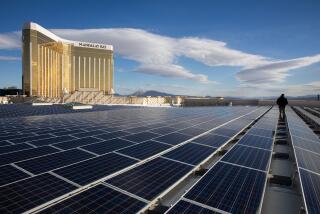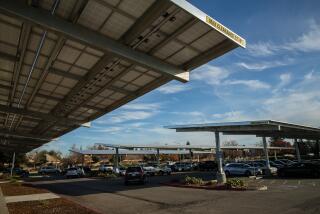Hong Kong Aiming High in Hopes of Harnessing the Sun
- Share via
HONG KONG — It may not be the answer to California’s power generation troubles, but for a corner of the world usually too busy turning a dollar to worry about energy efficiency, it’s an innovative first for harnessing alternative energy.
Hong Kong, a city built amid jutting peaks, is seriously exploring the idea of lining some of its steepest mountain slopes with solar panels. A feasibility study being conducted by the regional government’s Geotechnical Engineering Office is scheduled to be completed early in the new year.
If approved, detailed design work would likely take a few months, and then installation could begin, according to the project’s principal technical advisor, H.X. Yang, a solar energy specialist at the Hong Kong Polytechnic University.
Yang says it is too early to determine just how much of the city’s electricity could be generated by a large-scale deployment of solar panels. But if the idea is extended to include the facades and roofs of major buildings, the amount would be considerable, he believes.
Among the potential uses: powering the region’s 114,000 street lights, which last year consumed about $16 million worth of conventionally generated electricity. Owners of private high-rise apartment buildings carved into the slopes could deploy solar panels on the ground to capture power for the buildings’ outside lighting and internal communal areas, regional government officials say.
Some cities in the United States and Western Europe have reduced the need for conventional power by encouraging the use of solar panels on building facades, and Hong Kong could gain a unique advantage from its topography.
“Hong Kong is special because we’ve got so many slopes without grass or trees,” Yang said in an interview.
Government engineers say there are about 54,000 man-made slopes--excavated cuts into the mountainsides--in the Hong Kong region. Just over a quarter of these have been stabilized with concrete to prevent dangerous rockslides.
There is little resistance from environmental groups about the idea of deploying solar panels because the concrete-covered slopes are viewed as public eyesores. These areas also are costly to maintain because they require frequent safety inspections and periodic repair to prevent erosion.
The solar project grew out of a government initiative to explore ways of converting the slopes from liabilities into assets. When the plan became public last month, the leading English-language newspaper, the South China Morning Post, suggested in an editorial that the panels be “aesthetically appealing murals,” making the project as much about beautification as energy.
“It would be a double plus,” noted R.K. Tam, spokesman for the government’s Geotechnical Engineering Office. “We’d get rid of some ugly areas and generate electricity in the process.”
There is another important motivating factor for the Hong Kong government: keeping the city attractive to the foreign investment that lies at the heart of its remarkable prosperity.
In recent years, air pollution has become both a growing health problem and an oft-cited drag on the city’s efforts to entice new investors to the region. Any significant production of solar energy would reduce reliance on polluting conventional power plants.
Given Hong Kong’s weather patterns, the solar panels probably would produce excess electricity during the summer and fall, but they would need to be augmented during the cloudy winter and early spring periods.
During a test conducted on a sunny day in June, a series of panels deployed on the roof of a university building not far from the downtown area produced a maximum level of about 78 watts per square meter of solar panel. On a cloudy day, the production would be considerably less, Yang says.
The Hong Kong government also hopes that the the panels’ presence would send a pro-environment message to the city’s 6.7 million residents.
“It’s a way to improve awareness of the issue,” said Tam.
More to Read
Sign up for Essential California
The most important California stories and recommendations in your inbox every morning.
You may occasionally receive promotional content from the Los Angeles Times.













